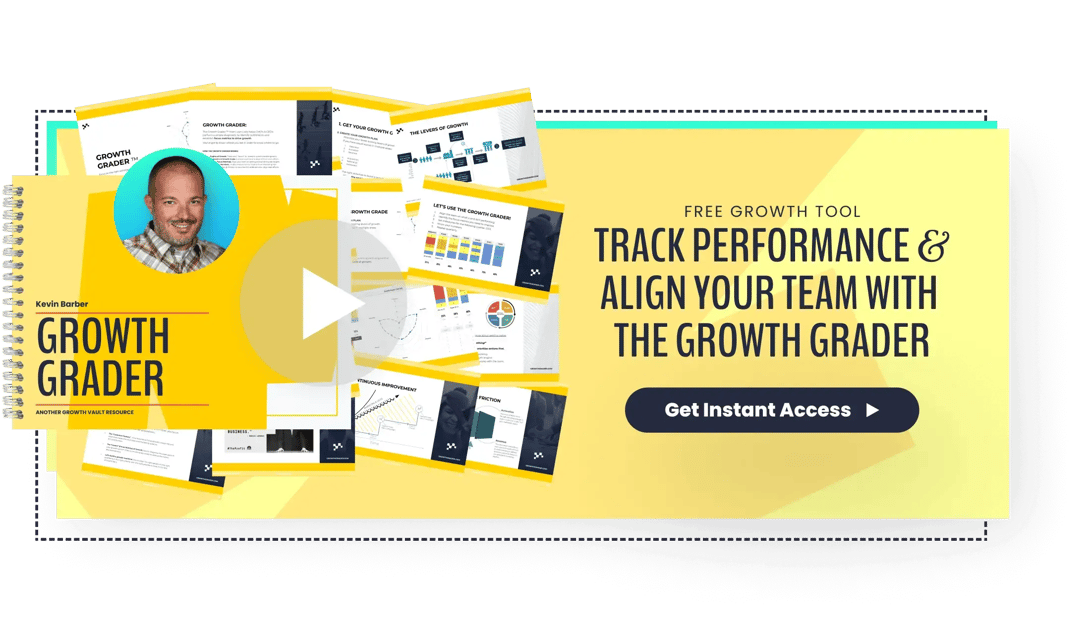If there’s one thing guaranteed to drain your marketing department’s time and resources, it’s reinventing the wheel.
The best artists borrow from other creatives. Singers sample other musicians’ songs, painters create homages to classic artists’ work… and marketers borrow proven tactics from other marketers. That’s why we’re writing this post: To give you the best B2B growth marketing strategies so you can adopt them and make them your own.
This post explores six incredible B2B growth marketing strategies that we use every quarter to reliably drive pipeline for our clients. We’ll cover each play in detail, giving you the exact steps you need to implement it in your business.
VIDEO TRAINING
Get The Growth Marketing Playbook.
Learn to plan, budget, and accelerate growth with our exclusive video series. You’ll discover:
- The 5 phases of profitable growth
- 12 core assets all high-growth companies have
- Difference between mediocre marketing and meteoric campaigns
Thanks for submitting the form!
We'll review the information you've submitted and respond to you just as soon as possible.
Why Use B2B Growth Marketing Strategies?
Many B2B companies rely on a subscription model. You want your customers to use your product or service, keep using it, and be delighted enough to buy the other products or services you provide and tell their friends how great you are.
With a growth marketing model, you can use the six levers of growth to take advantage of the buyer journey we just described.
Lever 1) Awareness - how many of the right people know about you and what you offer?
Lever 2) Acquisition - turning the people who visit your website into leads using a lead magnet.
Lever 3) Activation - nurturing those leads into sales-ready leads and convincing them to buy.
Lever 4) Revenue - quality leads turn into paying customers.
Lever 5) Retention - paying customers continue using your product or service.
Lever 6) Referral - your current customers tell their friends about you.
I’ve simplified the explanations, but the critical thing to remember is that there are six levers of growth, and all of them must work together to create growth.
Growth marketing strategies rely on data.
With teamwork between marketing, sales, and customer service teams, you avoid siloes and ensure you attract, engage, and delight your ideal customers.
With targeted campaigns, you can use data to see what’s working and what isn’t, so you can double down or pivot when needed.
Lean Labs uses growth marketing strategies with all of our clients. Each client is different, but the one metric they all focus on when working with us is growth—the north star.
And with $100m in directly attributable client revenue growth, we’re in a position to champion growth marketing and give you six strategies you can steal today.
Related: 7 Surprising B2B Marketing Growth Hacks to Maximize ROI
1. Posting Helpful Blog Content
Writing blogs is pretty straightforward. You can research how to format a blog post correctly; it doesn’t take much skill to publish a blog post. But a helpful blog post? That’s a different ball game.
Where many fall, is writing content for search engines instead of people. Yes, ranking high on search engine results pages is essential, as more people will see your content. But Google doesn’t actually like it when you stuff your content with keywords. In fact, Google makes frequent algorithm updates to help them identify and surface “helpful content”.
Write for people. Be helpful. Your blog content should speak to your ideal client. Writing about topics that aren’t related to your audience isn’t providing value; it’s just creating more noise in an already saturated market.
Your content should be thought-provoking and actionable, and leave your readers feeling like they’ve learned something valuable.
Here’s a checklist to ensure you’re writing for your audience:
- Would your ideal persona find this content helpful?
- Does your content demonstrate a depth of knowledge and expertise?
- What is the purpose of this piece of content?
- After reading this blog post, will the reader have learned something that they can take action on?
- Will the reader leave feeling like they’ve had a satisfying experience?
Related: [ULTIMATE GUIDE] Lead Generation Through Content Marketing
2. Exploring Freemium Access
When done correctly, freemium access can be a game changer.
The modern B2B experience dictates that the buyer has all the power. Before even speaking to a sales representative, buyers do a lot of research and even come to a conclusion on whether they want to work with you. Look at these statistics:
- Most B2B buyers are 57 percent of the way through the buying process before meeting a sales representative.
- When B2B buyers consider buying, most of their time is spent researching independently online.
With these statistics in mind, offering freemium access to your customers is a way to remove friction and show them the value they’d get from your product. Freemium access isn’t new. HubSpot, Zoom, and Dropbox offer freemium versions of their product.
The pros of freemium are obvious. People are more willing to try a new product or service when it’s free. You can then nurture them into paying customers. Also, your product’s unique value will drive acquisition, meaning you can lower customer acquisition costs.
The cons of freemium are three-fold. One, there’s no guarantee that free users will convert to premium users. Two, if you have too many features in your free plan, what’s the incentive to upgrade to a paid plan? And three, if you don’t provide enough value, you might lose your customers altogether.
To implement freemium well, think about the end goal: conversion rate.
- You need to leave a value gap that pushes users to upgrade. Create some friction.
- You could offer a full-featured free trial plus a free-forever plan. The free trial teases what they could get with the pro version, and once they transfer to the free-forever plan but lose access to all features, they’ll be incentivized to upgrade.
- Provide an exceptional customer experience. A fantastic onboarding experience and an impressive knowledge base could convince someone to continue working with you. Also, remind users that they’re on a limited plan and could get more out of the pro version of your product.
- Finally, track which users are approaching the free plan’s limits and those that spend the most time using your product. These users are better positioned to convert.
3. Repurposing Existing Content
It’s a simple concept. Find content you already have, and present it in a new format and in a new channel. With evergreen content, you have a library of helpful content to share with your audience.
You might think your audience will find your content repetitive, but you’d be surprised how often they might have missed it the first time. Also, new prospects are (hopefully) seeing content for the first time every day.
Content repurposing isn’t just reposting a blog post. It’s updating it with new data, thought leadership quotes, and giving it a new lease of life. You can also create stunning YouTube videos and post snippets on Twitter and LinkedIn.
How can you repurpose content?
- If you have a popular blog post, you can create a YouTube video with the content. How-to videos are beneficial to your audience, especially when the content is graphics-heavy.
- Create infographics. Not everyone wants to read a long blog post, but being able to visualize statistics and data quickly is helpful.
- Create a free training or course using the content. This can be an excellent lead magnet.
- Find heavy-hitting quotes in your articles and turn them into tweets on LinkedIn posts. It’s an excellent way to build authority.
Related: FREE GUIDE: The Complete Content Repurposing System
4. Using Your Voice (on a Podcast!)
Podcasts are unique.
Whether you start one on your own or bring in others for conversation, they’re a chance for people to get to know your brand or get to know you, personally.
What do you believe about your market? Where do you see the future of your corner of the market going over the next five years? Podcasts are a medium for your thoughts and a chance to position yourself as an expert in the modern landscape.
24 percent (68 million) of the population listen to podcasts weekly, up from 22 percent in 2019; the podcast future looks bright. Also, podcast listeners are more likely to follow companies on social media, so the chance for cross-promotion is high.
The unique thing about podcasts is that you have a clean slate. You can try new ideas, air slightly left-field thoughts, and see what resonates with your audience. It’s essential to test and change. You might also decide to start on your own and build confidence in your podcasting abilities before you bring in interesting guests.
Conversations, stories, and experiences draw people in, so your audience is captive while you have them there. Also, many people listen to podcasts when walking, running, or driving. They want to be entertained, and the more you entertain them, the deeper connections you build.
So don’t be afraid to be authentic. It’s your voice and your message.
Pro tip: Be a guest! Podcast listeners listen to podcasts. Find podcasts in your niche and pitch yourself as a guest on their show. You can return the favor, and you can both plug your own shows to a receptive audience.
5. Meeting Your Audience Where They Are
Remember, your customers are on a journey. First of discovery, then of epiphany, and finally, commitment. In more business-like terms:
- Awareness: They have a problem but haven’t quite figured out what it is.
- Consideration: They pinpoint their problem (with your help) and want to know more about how you can help them.
- Decision: They decide on you or another company that can solve their problem.
If you constantly push for a sale, you alienate the first two groups.
Marketing is a lot like dating. You wouldn’t walk up to strangers on the street and ask them to marry you (I hope!). So why are you doing that to prospects?
If you haven’t already built a relationship with a prospect, you need to start by building trust.
Give them value, show them you understand their business, what they’re struggling with, and you know how to help.
Related: 4 Reasons Your B2B Go To Market Strategy Is Broken (And How to Fix It)
6. Driving Retention and Referrals
Many businesses put a ton of effort into attracting and converting customers and then jump right back to step one and start looking for new customers.
But what about those customers you’ve just taken on a journey from not knowing you to becoming best buddies? Are you going to just forget about them now? How rude!
In all seriousness, a crucial step in growth marketing is driving retention and referrals, especially in the software and tech industries.
Often, your customers sign up for a subscription service. Ignoring them once they’re a customer is a mistake. Over 80 percent of customers are willing to pay more for a SaaS product if they have a better customer experience.
So how do you drive retention and referrals?
Delight, delight, delight.
It’s a strange word, isn’t it? Especially in the business world.
But think about it: If you surprise and delight your customers, they’ll not only want to stay with you, but they’ll tell their friends and professional circle about you, too.
- Create an engaging and complete onboarding experience. Leave a memorable first impression and focus on service. Make your customers feel welcome.
- Reach out to customers with surveys. Ask honestly how you’re doing as a service, what they love about you, and where you can improve. Your NPS (Net Promoter Score) is a metric you need to track.
- Maintain a communications calendar. Be proactive and keep your relationship going. These are great opportunities to upsell and cross-sell!
- Adopt customer service tools or even start a retention program.
Can you see how retention feeds referrals?
Customers are more likely to be loyal to you if you delight them. They’re more profitable than new acquisitions; crucially, 92 percent of consumers trust recommendations from friends and family.
When you proactively ask for a referral, a customer will first think, “What do I feel about this brand?” If only good things come to mind, they’ll happily refer you to their circle.
Pro tip: Offer incentives and rewards for referrals. A loyalty program can include gift cards, swag, upgraded features, and exclusive invites to events.
Leveraging Your B2B Growth Marketing Strategies to Maximum Effect
B2B growth marketing strategies like the ones listed in this post can help you improve your customer experience, reduce churn, and get a more sustainable return on your marketing investment.
It’s important to note that these strategies work best when implemented together and perform even better when implemented by an experienced team of growth marketing professionals.
If your team does not have a growth marketing team in-house, you may want to explore partnering with a hybrid growth team, like Lean Labs, to get your strategy off the ground while you hire the right people internally.
In the meantime, review our free Growth Marketing Playbook for additional tips, tricks, and plays you can use to scale your business profitably.







